
SUNDAY, FEB 19, 2023: NOTE TO FILE

Gaia Education Final Report
A short 8-week course in ecological design
Directive:
What is expected in the mini-design:
- A description of the problem or challenge and some context (location, current challenges, risks and opportunities, climate and other potential factors impacting the system you chose) - Maximum one page
- Context: is this your household, your community? - one paragraph or less
- Who would be the stakeholders if you were to interview them to explore more and test ideas? (example, in your household the stakeholders may be your housemates, your family, your pets and any usual visitor, your neighbours and the community at large) - one paragraph
- A description of your goal/goals in relation to the system of your choice - one short paragraph or bullet-point
- Your design: this may be a graphic/drawing explaining the changes or a paragraph or two explaining the things you would change or implement and how. (no more than one page)
- An analysis of the potential challenges and the expected opportunities you see in this design - one paragraph
- An analysis of how this design applied to this system may affect or interact with other systems (example, what happens to the food when you make changes to the source, use and disposal or water? what happens to the energy? etc. - one paragraph or two
- An analysis of how do you expect the impact or interaction with the other dimensions (social, economic and worldview). Example: what happens with the family economics when you change the source and use of the food you consume? what about their worldview? the social dynamics? - one or two paragraphs.
You can add links to sources, pictures, drawings, tables or videos but keep it simple. This is your practice for the bigger project you will embark in the Design Studio, so have fun!
Here is the space [forum page] that you can share your final report. You can provide it in any form such as text, video, audio, art, etc.
You are asked to reflect on and respond to the following questions:
What did I learn in this course?
What surprised me, challenged my beliefs or updated my skills?
In what ways have I changed my perspective or patterns of my consumption and use of stuff? How has my relationship with the basic systems that sustain my life (water, food, energy, housing, transportation, waste) has changed?
How do I plan to use this material in my life, work, school, or community? How might I use it in my Design Studio later in the GEDS course?
Any other reflection or expression you want to share.
The final (and only) report can be posted to the forum in any format and one student did their report as a 15 minute MP3 file. I was not able to listen beyond a minute.
My report: Ocean Restorer II to the Poles
In this course I learned that “the problem is the solution” [Bill Mollison]. The problem is that modern techno-industrial society is not remotely sustainable. Container/cargo ships cannot be powered by fossil fuels forever. Polar ice caps melt, sea level rises. Antarctica will again be habitable. Humans will need to adapt.
I thought there were no solutions. We have many problems, and all have surprising solutions as I have learned about.
"For every complex problem there is a solution which is clear, simple and wrong." H.L. Mencken
I have changed in that I no longer seek to live in modern techno-industrial society. I would rather sail the world as part of a solar nomad culture. During the transition, all current lands will be full of inhabitants, so seek out and create new places to live in which all water, food, energy, housing, transportation, and waste is handled in a manner that works sustainably as the millennia pass.
As I will not be living alone on a mountain top, I plan to find 200 other sailors to form four ecovillages (50 inhabitants each) to sail the world on repurposed wind powered cargo ships.
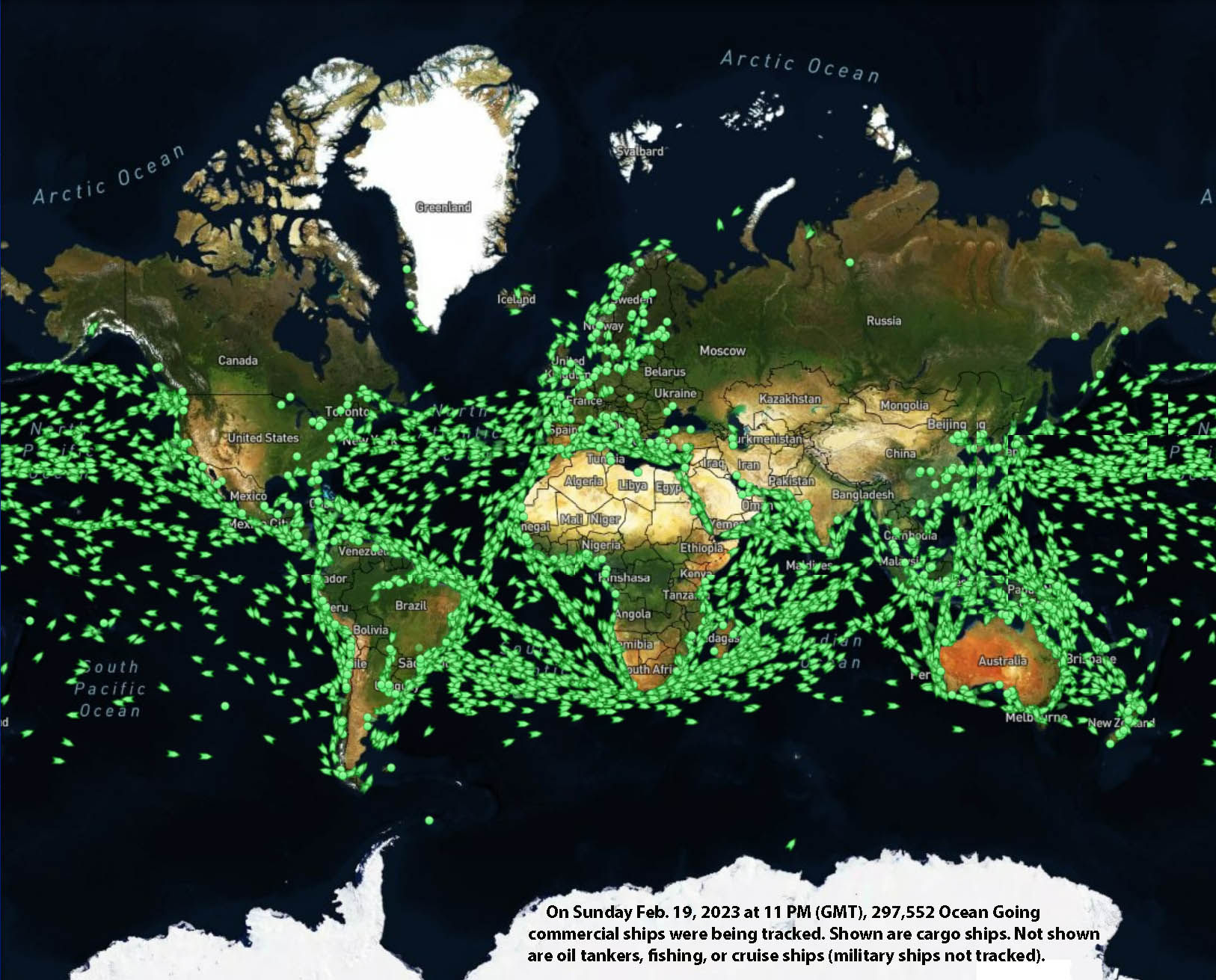
The above are only the cargo ships. About 6,000 of the above are container ships. Any two ships of the same length could be joined by a crossbeam deck and outfitted with sails, and will have to be to stop using fossil fuels (all the 297k commercial ships are fossil fuel powered).
Each tandem catamaran ship, with 2 ha of deck farm, would be the crews home in four ecovillages. Each ship would be a sailable island that would pass near shores allowing smaller vessels to tie up and off-load or take on passengers and cargo. The crew of Permanauts would anchor for four months near each pole when the sun shines 24 hours a day.
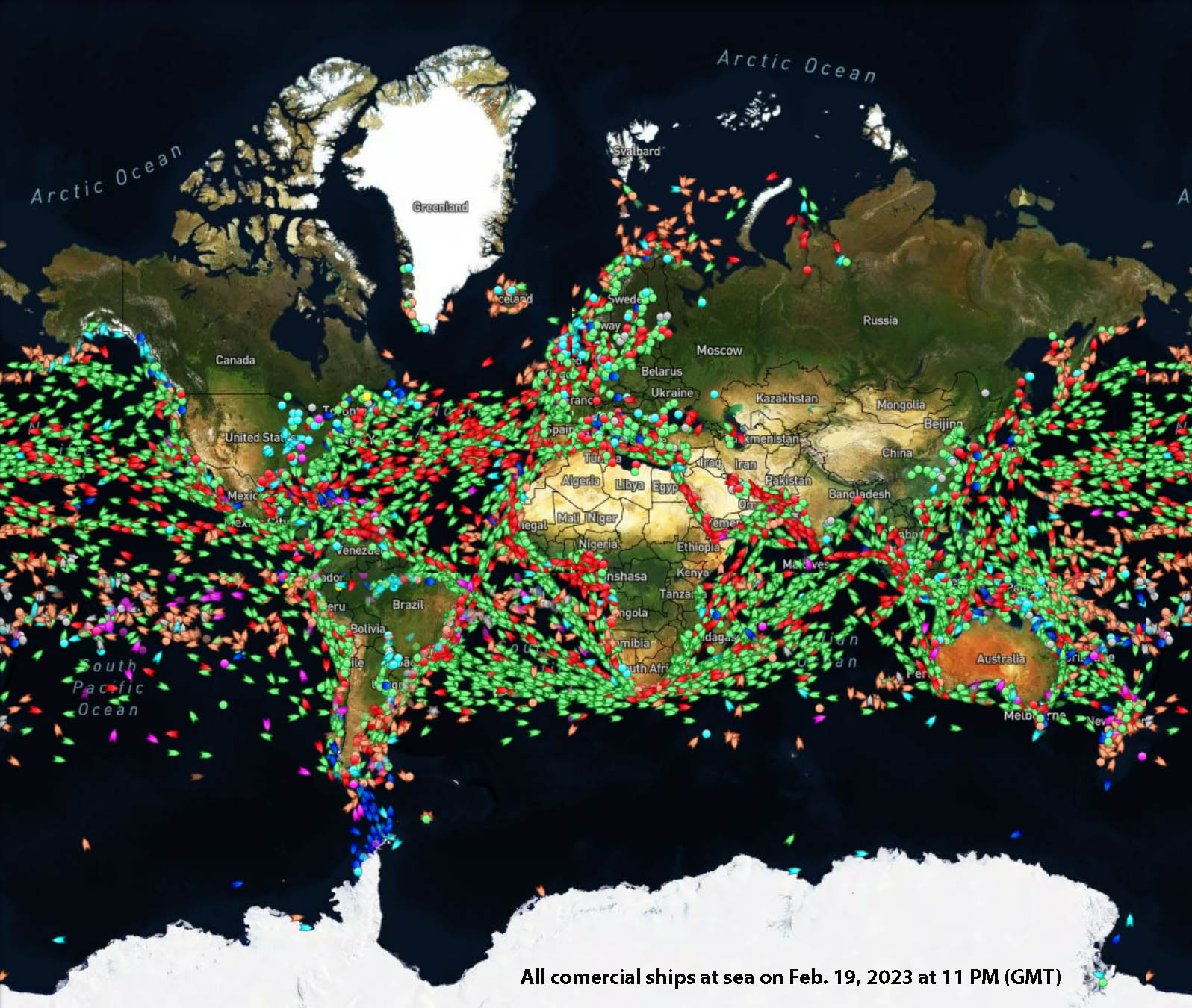
As a citizen of Earth (unlike Elon Musk), I don't plan on retiring on Mars. My community is an oblate spheroid inclusive of all life known and unknown to us humans, the last hominin standing. The Anthropocene will end, and sooner will be better. To flourish as the epochs and eons pass, humans will need to understand the planet and learn to live with it properly. The challenge of doing so may be impossible to overestimate.
My design project is to envision how 200 sailors will live on two modified container/cargo ships that are wind and solar powered. Wind moves the ships so they can follow the sun to the North Pole during its four months of 24 hour/day sunshine, then sail south, with never less than 12 hours of sun when crossing the equator, onward to Antarctica, reaching it within four months while picking up cargo and passengers who want to go south, then farming the 24 hour per day sun of Antarctica before repeating the voyage back to the North Pole.
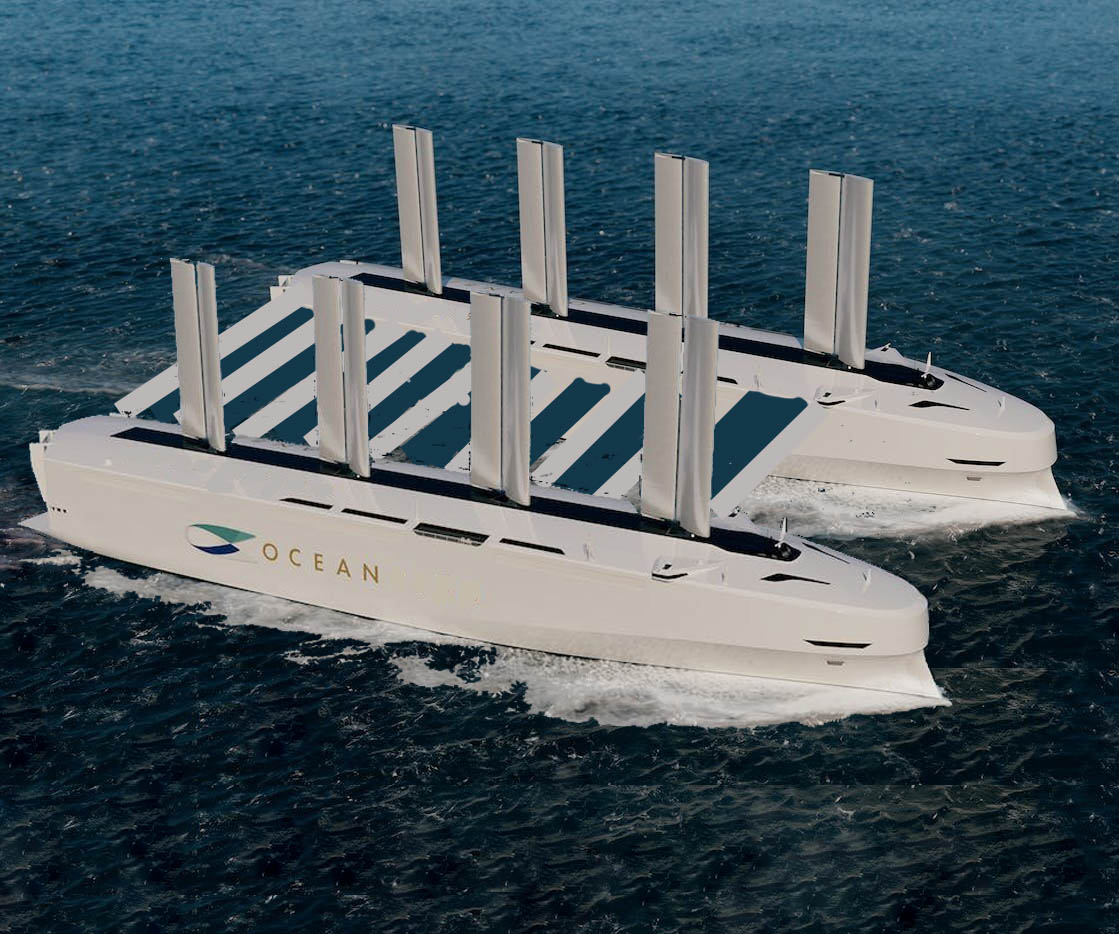
With continued global warming, Antarctica will again be habitable, and it will be by permaculturists who will form a new, viable and vibrant culture in Permarctica to show the rest of the world how to live properly with the planet.

"There have been seven [climate change] disasters since humans came on the earth, very similar to the one that's just about to happen. I think these events keep separating the wheat from the chaff. And eventually we'll have a human on the planet that really does understand it and can live with it properly. That's the source of my optimism." James Lovelock, student of Gaia.
I seek to create the conditions that will select for such humans. Some details follow:
There are over 5,600 container ships plying sea routes worldwide, so soon figure 6,000 container ships that will need to be repowered after fossil fuel use ends. Set aside 2,000 as replacements, and convert 4,000 into 2,000 Ocean Restorer IIs by reconfiguring them as catamarans with each having 4 ecovillages for a total of 8,000 ecovillages for 2,000 crews of 200 totaling 400,000 permasailors who provide needed cargo and passenger transportation in the low energy world to come.
Panamax class average container ship:
4,500 TEU (1 TEU = 1 20' shipping container)
876' length ft 266 m
106' beam ft 32.3 m
39' draft ft 12 m
24.1 speed knots (28 mph) when powered by fossil fuel, 10 knts when powered by wind.
43560 sq ft per deck, 2 acres total plus 3 acres of crossbeam area (2 ha).
Catamarans have a beam to length ratio of roughly 50%, or 2:1, so average Ocean Restorer II is 133 m wide.
The crossbeam deck area is 3 acres and would be designed as a tide pool supporting many species of planets and animals that work, empowered by the sun, to filter and purify seawater. Total deck area is 5 acres (2 ha). All water passing between the hulls will be scooped of flotsam, mostly plastic, that will be removed from the ocean world.
As per the Ocean Restorer design, sails could be of the ancient Chinese type.

Sails could be fixed, but able to extend upward.This form of sail is a current design, the Oceanbird plan to power cargo ships by wind.
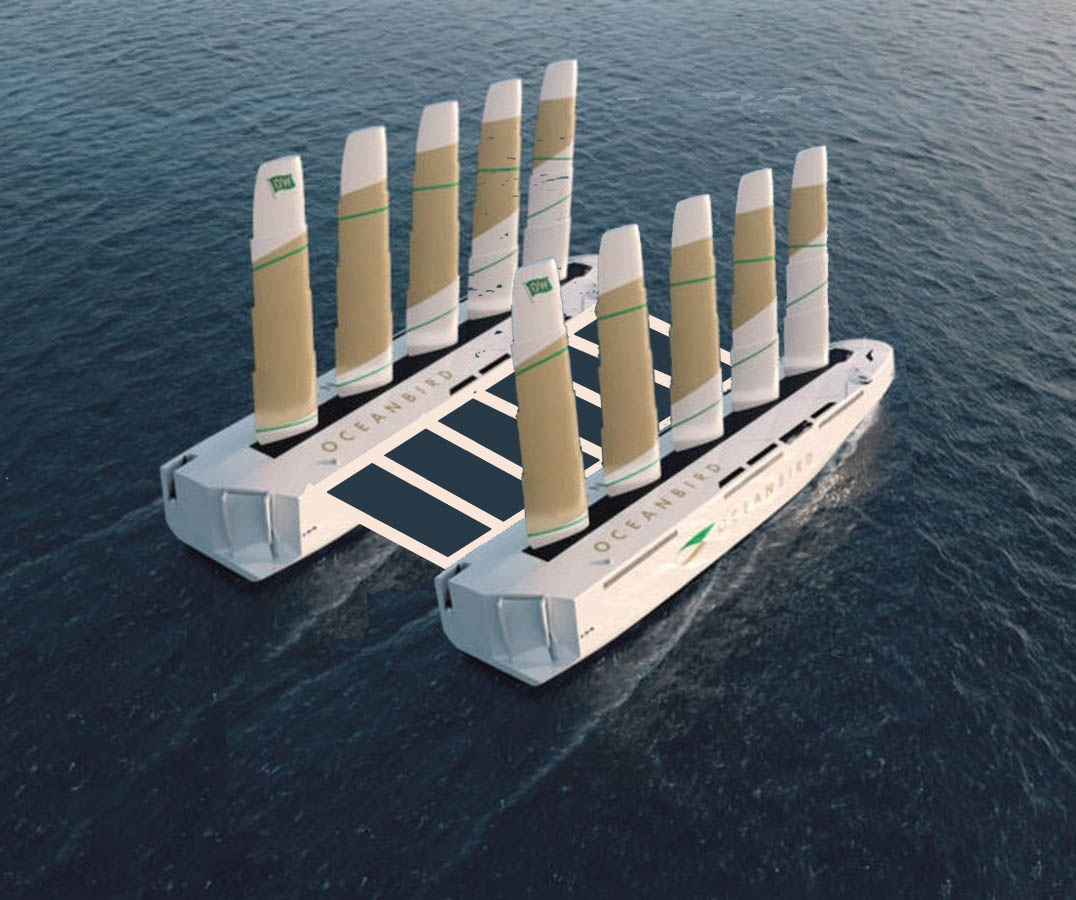
Sails could be repurposed wind turban blades (when one of three blades fail after maybe 20 years, all would be replaced, so two could be repurposed or be viewed as industrial waste). When one blade fails of three on a wind turban, all three will be replaced, but two would serve as vertically mounted fixed sails able to rotate to catch the wind or point into the wind to depower the ship at anchor.
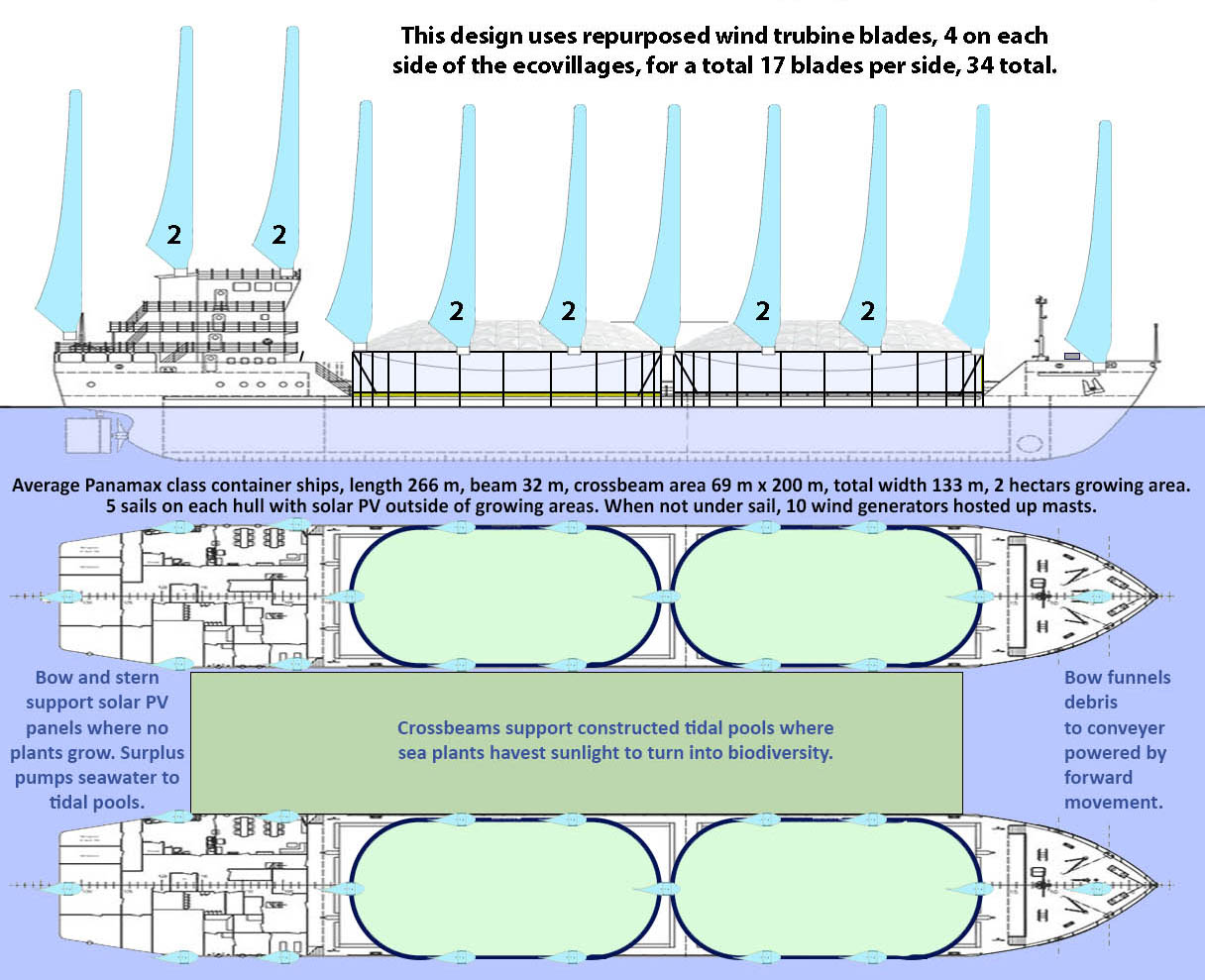
Each hull would support two ecovillages, a half acre each with residents living in Hobbit holes under the planted surface (roof) in 20' x 8' x 8' converted shipping container below the greenhouses above optimized to take in the 24-hour low-in-the-sky 24 hour sun while skylights would allow enough sun in near the equator and the roof would provide needed shade to prevent overheating in the tropics. During transit, livestock production would be by raising hogs (4 to 6 months) and trading high value smoked/cured hams/sausages to replace supplies of other foods and feeds. At the poles, breeding stock would be part of the ecovillage farm consumption and production system.
The ship's hulls would contain 9,000 20 foot long containers each, some with ends removed to create corridors allowing for loading and unloading of containers that are a permanent part of the ship. The upper layer would be converted into tiny homes for crew and passengers during transit. Other containers would be for cargo, and some would be homes for hogs.
Half of the crew (25 sailors) from each ecovillage would serve as active duty crew for 6 hours every other day during the 4 month transit of their Ocean Restorer II vessel. There would be time enough to love and learn, to really come to understand the planet and learn to live with it properly. Most humans, in their youth, before raising a small family, could serve as sailors to see and learn about the world. More would be learned in four years aboard than at a university in the not so good-old days, and spending six to eight years aboard would not be too much learning for some who could become the world's teachers who, having learned from Gaia, would have something of value to teach.
During transit, each ship is an island. Mainland ships would sail up to and dock along side to transfer cargo and passengers. The Ocean Restorer IIs would not have to stop or anchor, but would always be moving to remove flotsam and purify seawater as it flows through the crossbeam tide pools to do its job of ocean restoration.
Crew could take half a year off to live on land while new crew joins those who stay with the ship. The crew would be world teachers and learners working to help all to transition form the non-viable modern techno-industrial form of expansionist (growth) civilization to a viable (permanent) form of civilization based on understanding and learning to live with the planet as Earth Guardians.
SUBNOTE TO FILE 2/20/23
I had posted a comment to another student's post critical of wind turbines that cited vetted data. This was the only note of differing with the pro-wind lessons. To be supportive I added:
Average new wind turbine (blades are 52 m in length) installed today is 2.75 MW, but average of all installed wind turbines is about 1.5 MW maximum rated production. Total global wind power capacity is now up to 837 GW or 837,000 MW if the wind was blowing optimally everywhere. I couldn't find a number for total installed wind turbines, but 837,000 MW/1.5 NMW = 558,000 wind turbines. All have at least 2 blades and most have 3. Blades may last 20 years or so before a new blade has to replace it. Likely if one fails, the other two will be replaced, so if the average blade lasts 22 years, one would likely fail before 20 years had passed, and all three would be replaced (if any are).
Currently there are 3,800 incidents of blade failure each year, but most are not nearly 20 years old yet. If no more were built, 558,000 x 2.9 blades/turbine = 1,618,200 blades / 20 years = 80,910 blade failures/year. Wind produces about 2% of world energy, less than the growth rate in the demand for electric energy. If ten times more wind turbines are made (annual grow is 13%, so number will double in 5 years, but growth rate is increasing, so a ten fold increase in 8 years is likely) electricity production from wind will not meet demand, but could create 800k failed blades per year.
The rest of each turbine would also have to be replaced at some point, including the concrete which, like all concrete that makes up today's infrastructure, has a life expectancy of about 150 years. Today's wind turbans wouldn't exist without near illimitable subsidies (both money and fossil fuels used to make them), and if such subsidies are not provided to replace them every 20 years or so, then they won't be replaced. Modern techno-industrial society is building ruins.
Obviously the solution is the problem, so we'll find some essential use for old blades and 800k/year won't be enough, so no need to make them last 20 years. All the container ships will need sails. When one blade fails, the other two haven't, will be replaced, and will be free to install vertically on container ships that sail the world's oceans at up to 10 knots (down from today's 25 kts).
This relates to my final report/design, but it was already longer than it needed to be, so didn't add points made in the comment.
